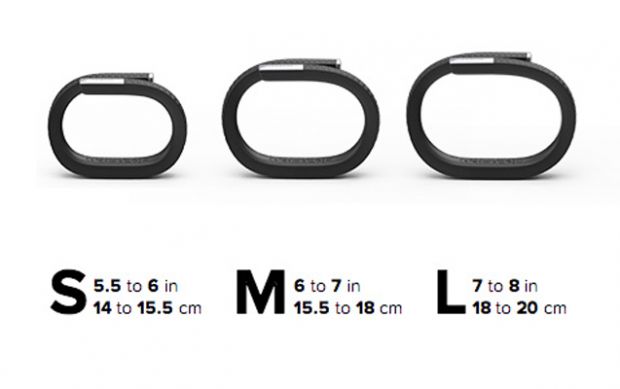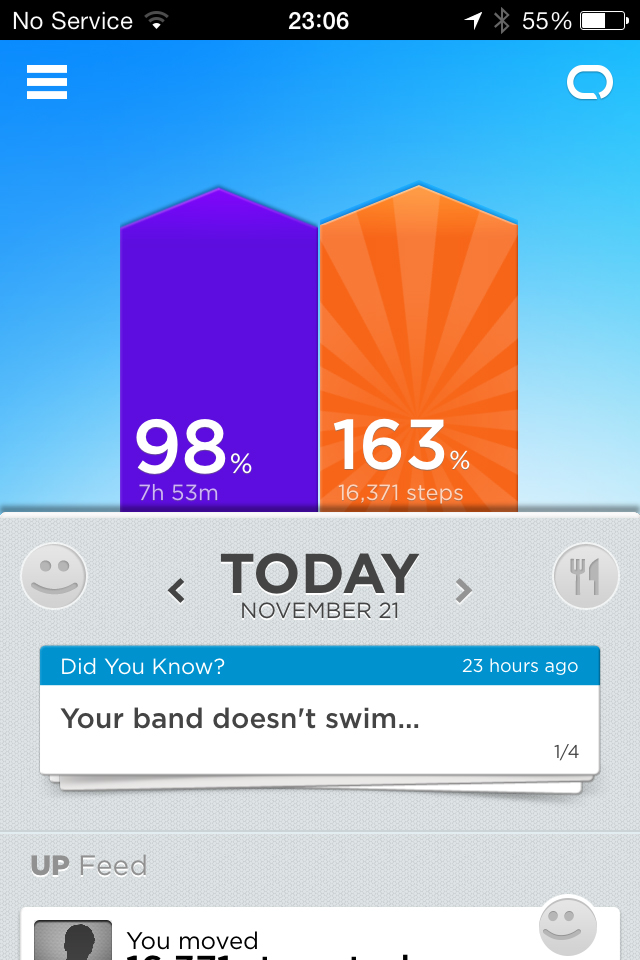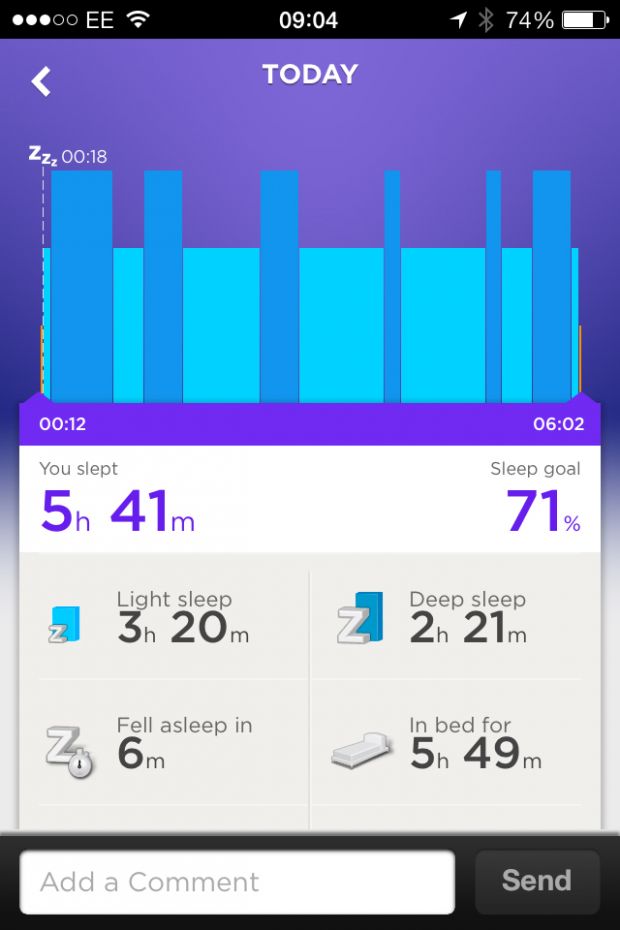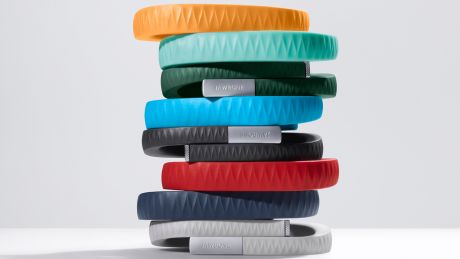You can trust Coach
In 2011, the original Jawbone UP started the trend for wrist-based activity trackers, promising to marry its stylish good looks with a feature-packed system that could improve your health – and your life. Unfortunately the original design was flawed, resulting in a costly recall and refund by Jawbone.
But rather than cutting its losses and moving on, Jawbone went back to the drawing board and created a new version of the UP, this time confident in both its ability and durability. And we’re glad it did. The second-generation UP is a big improvement on the first and although it isn’t perfect, we like it far more than we expected to. So, without further ado, here is our in-depth Jawbone UP review.
READ OUR OTHER ACTIVITY TRACKER REVIEWS
UP and running
Don't be fooled by the basic design. Under the hood, this innovative wrist band has the computing power to track almost every physical aspect of your life. Most importantly, for people who train regularly, it calculates distance travelled, calories burned and intensity, so it's able to differentiate between a walk and a CrossFit workout. To complete your daily picture, the UP also tracks your movements during sleep to tell you how effectively you're resting.
There’s also no denying that the Jawbone UP's basic design makes it the best-looking activity tracker for your wrist. We’re not saying you’ll want to dump your Rolex Submariner in favour of one but, compared with the competition, it’s the most stylish and unobtrusive option. The UP is available in four colours – Onyx (black), Blue, Mint Green and Light Grey. You can choose between small, medium and large sizes, and unlike other activity trackers, you need to get your choice right, since there’s no way to adjust the size of the band.

In fact the Jawbone UP isn’t a wristband at all in the traditional sense, since it’s not a closed loop. The UP is a moulded but flexible band that you can deform and twist to get it on your wrist, after which it will return to its normal shape.
The UP is extremely comfortable to wear, and far easier to fit and forget than other wristbands. It’s very light too – the medium version weighs only 22g. The textured finish on the band stops it from moving around too much, and it doesn’t sit tight enough for sweat to build up underneath it when you’re training.
You’ll need to charge the battery inside your UP when you first unbox it, but much like the Fitbit Flex that we reviewed recently, there’s no standard USB port on the UP. The only connector on the device takes the shape of a 3.5mm headphone jack, so you need to use the bundled USB adapter cable to charge the battery.
Once fully charged, the battery will be good for around ten days of constant use, day and night. That’s market-leading battery life, but there’s a good reason for it, which we’ll come to a little later.
While your UP is charging you’ll want to register for a Jawbone UP account and download the app for your smartphone. The UP app is available for both iOS and Android, and in our test it worked flawlessly with an iPhone 4s.
Keeping track
The Jawbone UP has a clever little accelerometer built into it, which can measure any form of activity and movement while you’re wearing it. This data is used to measure steps taken, and consequently distance travelled and calories burned. (Without heart rate data, the calories figure is an estimate – but since every other activity tracker claims to measure calorie burn, we can’t hold that against the UP.)
Much like the Fitbit Flex, the UP can also discern between gentle and active movement. So if you’re out for a run, the UP will measure those minutes as active when you sync the band with the app. You’ll be presented with a bar graph that highlights how active or lazy you’ve been throughout the day – it can make for grim reading if you’re generally tied to your desk during the working week.
As well as recording your activity, the UP can also track and analyse your sleep patterns. To switch the UP from waking to sleeping modes you simply push and hold the button (there’s only one) until the unit vibrates. The UP will remain in sleep mode until you repeat the button push in the morning. Speaking of which, you can also set it to wake you in the morning. Like the Flex, the UP supports silent, vibrating alarms, allowing you to wake up when you need to without disturbing your partner.
While we criticised the Fitbit Flex for displaying almost no information on the device itself, the UP takes things to the next level. There’s absolutely no data displayed on the device apart from whether it’s in waking or sleep modes – not even a light to tell you if you’ve hit your daily goal. The only way to find out how you’re doing throughout the day is to fire up the app on your phone and sync your data from the UP, but that’s not as easy as it should be either.
Synching your data
Unlike every other fitness tracker available, the Jawbone UP cannot connect to your phone wirelessly. This is all the more baffling when you consider that Jawbone has built its reputation on designing and manufacturing Bluetooth wireless devices. Despite its Bluetooth expertis, Jawbone decided that to sync the UP with your phone, you’d have to physically plug it into the headphone socket. Remember that 3.5mm headphone jack connector? Now you know why it’s there.
This outdated method of synching your data makes the lack of display on the UP all the more frustrating. To find out how you’re doing, you need to take out your phone, open the UP app, remove your UP from your wrist, remove the protective cap from the 3.5mm jack, plug your UP into your phone and wait for it to sync your data.
As a result we found we simply didn’t check our stats throughout the day – since it’s just too much hassle. We generally synchronised data in the evening before going to bed, so we could look back at the day and perhaps compare it to the last. This diminishes the UP’s usefulness, since the real advantage of an activity tracker is that it allows you to see if you need to get up out of your chair and get active during the day. If you’re only checking how active you’ve been last thing at night, it’s already too late.
Jawbone has tried to address that issue. You can activate vibrating alerts, so if you’ve been sedentary for too long, your wrist will buzz, indicating that you really should get up and go for a walk, or climb up and down the stairs a few times. There’s no altimeter in the UP either, so any steps you take up flights of stairs are just steps according to the UP. To be fair, the Fitbit Flex didn’t measure elevation either, but the Fitbit One does, as does the feature-rich Withings Pulse.
The UP app
This is a fine example of a companion app for a fitness device. It’s well laid out and attractively designed. The main display will show you how much sleep you’ve had recently, how active you’ve been and what you’ve eaten. The latter is a great feature that we would like to see in every fitness device companion app, and while the food tracking aspect of the Fitbit Flex app was good, the UP app takes it a step further. (Don’t take much notice of the app’s customer ratings – much of the criticism was levelled at the early version, which Jawbone has acknowledged and fixed with the new UP.)

The UP app can call on a database of food types to track what you’re eating throughout the day. You can search for a specific food, and if it’s in the database it will be logged with all its composite attributes. To make things even easier, Jawbone has build a barcode scanner into the app, so you can simply scan your food and the app will automatically find and log it. Of course you can also manually log any food that’s not in the database.

You can also log training sessions within the app. This feature isn’t as advanced as the Sessions supported by the Nike+ FuelBand SE (review coming soon), but it’s still handy to be able to add a run or bike ride to your timeline. To add a training session you log the time you started, the duration of the session and what the activity was. This helps get around the fact that active minutes can range from a brisk walk all the way up to a full-on sprint.
You’ll periodically get tips and hints on how to improve your health, fitness and general lifestyle – these are presented as sticky notes on the main app screen. You’ll also see a log of your streak – the number of days in a row that you’ve managed to hit your activity goal.
Conclusion
The biggest issue we have with the Jawbone UP is its lack of wireless synching. The need to remove the UP from your wrist, take off the protective connector cap and physically plug it into your phone every time you want to sync data is frustrating to say the least. This frustration is compounded by the fact the device itself shows no information whatsoever. Jawbone is clearly aware of this frustration, though, since in the US it has recently released the UP 24, which does include Bluetooth phone synchronisation. There’s still no display on the device, but at least your data is automatically updated on the app without the need for physical interaction.
The lack of wireless connection does bring one advantage to the table though – the battery life for the UP is truly outstanding. we haven’t needed to charge the UP at all since we started testing it over a week ago, so we wouldn’t argue with Jawbone’s estimate of ten days’ use.
The supporting app is also excellent, and gives you a clear indication of your activity, quality of sleep, food intake and even your exercise sessions. As a motivation tool, the app is actually better than the UP.
Although there’s much to like about the UP, when you factor in its £99 price, which represents a £20 premium over the Fitbit Flex, it’s hard to recommend Jawbone’s activity tracker over the competition. That said, when the UP 24 lands in the UK, that could all change.
Score: 7/10
Price: £99
Manufacturer: Jawbone

